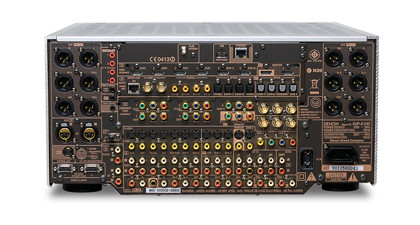The future of AV receivers
Why your AVR does more than just amplify your sound
Internet radio and networked-streamed audio is already a given on any serious AV receiver, but the future will see seamless two-way streaming of HD video content over the network, as well. Downloading movies in HD from providers such as LOVEFiLM and BBC iPlayer, and punching that content around the home over wired and wireless networks, will be the must-have features on range-topping receivers from as early as autumn 2011.
From here, it is not a huge leap of faith to see AVRs becoming a hub of not just AV content, but also an access point to a raft of other wider network services including social media, email, IM and even mass multiplayer on-line games.
Roger Batchelor, consulting guru at Denon, also sees networked content as the future of AVRs, but is keen not to lose sight of the underlying performance criteria.
'Beside the fact that good sound quality is the essential when designing AVRs', he says, 'we think additional network functions and access to mobile devices are likely to be the most appreciated features. Our current range of receivers offers access to thousands of internet radio stations and iTunes via Apple AirPlay, plus access to music services such as Napster, Last FM and the photo service Flickr. The breadth of content will grow into the future so we are thinking about how to improve AVR ease-of-use as much as possible.'
Keep it simple
Operational simplicity will be one of the bigger challenges for makers over the next few years as AVRs integrate PC-centric services without the benefit of a mouse or keyboard. Having a flexible and infinitely updateable AVR remote control will be fundamental to this success, and Pioneer's awesome iControl AV app for the iPhone/iPod Touch has shown the way forward in this respect.
Every manufacturer is developing a remote control app for their network AVRs, because smart phones and web tablets are the perfect remote control device. They offer full-colour, touchscreen interfaces with as many menu levels as is needed, delivered with pretty and easy-touse GUIs, and can be updated and upgraded as often as required.
Get daily insight, inspiration and deals in your inbox
Sign up for breaking news, reviews, opinion, top tech deals, and more.
Once the first tranche of remote control apps has emerged, I suspect we will see constant development in this area, including user-configurable interfaces, customisable GUIs, macro facilities and open source multi-brand apps, creating a sort of 'app-for-all' remote control. It then rather poses the question why bother supplying a normal button remote control with an AVR at all?
Making a standard remote an optional extra would reduce the AVR cost for buyers already in possession of a suitable iPhone or web tablet. Asking AVR makers directly, the jury is still out on that concept becoming reality.
One thing all manufacturers do agree on (officially or otherwise) is that the growing number of amplified channels is not necessarily a good thing. Implementing nine channels of amplification, or perhaps even more for full Audyssey DSX, is not technically difficult, but it is expensive and virtually no one will use it.

Most AVR owners only have a 5.1 speaker setup with the spare two channels of amplification either laying redundant or sometimes used for bi-amping or multi-zone duties. The move to launch nine or 11-channel amps lower down the market is simple numbers-trumps, and once one manufacturer has started it, the rest will follow to keep up with the Joneses.
Phillippe Coppens, European Product manager at Pioneer, sees the benefit of a larger number of channels more in terms of the AVRs' overall flexibility: 'For some users more amplifier channels is a benefit, but not always directly as a 7.1 or 9.2 setup, for example. We offer flexible re-assign options that allow various configurations. Many users of our flagship SC-LX90 Susano amplifier assign its 10-channels of amplification to bi-amp a five-channel setup. The general trend to increase the number of amps in mainstream products is largely a result of market dynamics.'
Whether you use 5.1, 7.1 or even 11.3 channels of processing and amplification, the sound quality of today's AVRs is nothing short of jaw-dropping. Uncompressed HD audio formats such as Dolby TrueHD and DTS-HD Master Audio have transformed movie soundtracks, and developments in RoomEQ, jitter reduction and improved DSP technology mean today's receivers can deliver sonic fireworks to shame most commercial cinemas.
From budget to high-end, AVRs are more flexible than ever, much easier to use than ever before, and offer a seamless portal to a vast range of networked content that is set to grow and grow. With so much more exciting AV technology on the horizon, the AVR is finally taking up its rightful place as the beating heart of home entertainment.